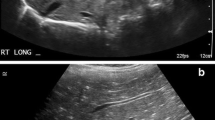Abstract
Background
We encountered multiple cases in which the US appearance of ruptured appendicitis mimicked intussusception, resulting in diagnostic and therapeutic delay and multiple additional imaging studies.
Objective
To explore the clinical and imaging discriminatory features between the conditions.
Materials and methods
Initial US images in six children (age 16 months to 8 years; 4 boys, 2 girls) were reviewed independently and by consensus by three pediatric radiologists. These findings were compared and correlated with the original reports and subsequent US, fluoroscopic, and CT images and reports.
Results
All initial US studies demonstrated a multiple-ring-like appearance (target sign, most apparent on transverse views) with diagnostic consensus supportive of intussusception. In three cases, US findings were somewhat discrepant with clinical concerns. Subsequently, four of the six children had contrast enemas; two were thought to have partial or complete intussusception reduction. Three had a repeat US examination, with recognition of the correct diagnosis. None of the US examinations demonstrated definite intralesional lymph nodes or mesenteric fat, but central echogenicity caused by debris/appendicolith was misinterpreted as fat. All showed perilesional hyperechogenicity that, in retrospect, represented inflamed fat “walling off” of the perforated appendix. There were four CTs, all of which demonstrated a double-ring appearance that correlated with the US target appearance, with inner and outer rings representing the dilated appendix and walled-off appendiceal rupture, respectively. All six children had surgical confirmation of perforated appendicitis.
Conclusion
Contained perforated appendicitis can produce US findings closely mimicking intussusception. Clinical correlation and careful multiplanar evaluation should allow for sonographic suspicion of perforated appendicitis, which can be confirmed on CT if necessary.




Similar content being viewed by others
References
Cogley JR, O’Connor SC, Houshyar R et al (2012) Emergent pediatric US: what every radiologist should know. Radiographics 32:651–665
Anderson DR (1999) The pseudokidney sign. Radiology 211:395–397
Del-Pozo G, Albillos JC, Tejedor D (1996) Intussusception: US findings with pathologic correlation—the crescent-in-doughnut sign. Radiology 199:688–692
Sivit CJ (1993) Diagnosis of acute appendicitis in children: spectrum of sonographic findings. AJR Am J Roentgenol 161:147–152
Daneman A, Navarro O (2003) Intussusception. Part 1: a review of diagnostic approaches. Pediatr Radiol 33:79–85
Van Breda Vriesman AC, Puylaert JB (2006) Mimics of appendicitis: alternative nonsurgical diagnoses with sonography and CT. AJR Am J Roentgenol 186:1103–1112
Krishnamoorthi R, Ramarajan N, Wang NE et al (2011) Effectiveness of a staged US and CT protocol for the diagnosis of pediatric appendicitis: reducing radiation exposure in the age of ALARA. Radiology 259:231–239
Williams H (2008) Imaging and intussusception. Arch Dis Child Educ Pract Ed 93:30–36
Ko SF, Lee TY, Ng SH et al (2002) Small bowel intussusception in symptomatic pediatric patients: experiences with 19 surgically proven cases. World J Surg 26:438–443
Lioubashevsky N, Hiller N, Rozovsky K et al (2013) Ileocolic versus small-bowel intussusception in children: can US enable reliable differentiation? Radiology 269:266–271
Tejani C, Phatak T, Sivitz A (2012) Right lower-quadrant pain—more than one diagnosis. Pediatr Emerg Care 28:1224–1226
Christianakis E, Sakelaropoulos A, Papantzimas C et al (2008) Pelvic plastron secondary to acute appendicitis in a child presented as appendiceal intussusception. A case report. Cases J 1:135
Dietz KR, Merrow AC, Podberesky DJ et al (2013) Beyond acute appendicitis: imaging of additional pathologies of the pediatric appendix. Pediatr Radiol 43:232–242, quiz 259
Conflict of interest
None
Author information
Authors and Affiliations
Corresponding author
Rights and permissions
About this article
Cite this article
Newman, B., Schmitz, M., Gawande, R. et al. Perforated appendicitis: an underappreciated mimic of intussusception on ultrasound. Pediatr Radiol 44, 535–541 (2014). https://doi.org/10.1007/s00247-014-2873-8
Received:
Accepted:
Published:
Issue Date:
DOI: https://doi.org/10.1007/s00247-014-2873-8




